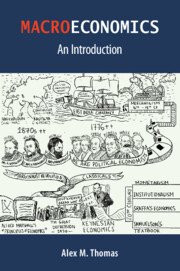Book contents
- Frontmatter
- Dedication
- Contents
- List of Illustrations
- List of Figures
- List of Tables
- Preface
- Acknowledgements
- Note to the Reader
- 1 What is Economics
- 2 Conceptualising the Macroeconomy
- 3 Money and Interest Rates
- 4 Output and Employment Levels
- 5 Economic Growth
- 6 Why Economic Theory Matters
- 7 The Policy Objective of Full Employment
- 8 The Policy Objective of Low Inflation
- 9 Towards Good Economics
- Data Sources
- References
- Index
Preface
Published online by Cambridge University Press: 08 June 2021
- Frontmatter
- Dedication
- Contents
- List of Illustrations
- List of Figures
- List of Tables
- Preface
- Acknowledgements
- Note to the Reader
- 1 What is Economics
- 2 Conceptualising the Macroeconomy
- 3 Money and Interest Rates
- 4 Output and Employment Levels
- 5 Economic Growth
- 6 Why Economic Theory Matters
- 7 The Policy Objective of Full Employment
- 8 The Policy Objective of Low Inflation
- 9 Towards Good Economics
- Data Sources
- References
- Index
Summary
At the very outset I must confess that I did not want to write a textbook. This is because all economics textbooks, except for a few, are essentially the same in their core content and presentation. In particular, there is no recognition of pluralism in theoretical approaches. My engagement with economics in varying capacities—as a student, a teacher, a researcher, a blogger and a commentator—has mostly dealt with a critical appraisal of mainstream economics and the strengthening of an alternative approach inspired by Adam Smith, David Ricardo, Karl Marx, John Maynard Keynes and Piero Sraffa. Both my interest in this alternative approach and the need to present the same to a wider audience persuaded me to organise and document my approach to macroeconomics in a written form.
Besides my desire for documentation, another motivation for writing this book arises from the need to provide good texts (even in the form of a short extract) to students studying in Indian colleges and universities where libraries are not well stocked. I vividly remember, as an M.Phil student at the University of Hyderabad (which has a reasonably well-stocked library), how I had struggled to obtain the materials I required for my research on the economics before Adam Smith. Fortunately, I received help from friends who were in other Indian universities and from historians of economic thought based in foreign universities. I hope that the short extracts, book suggestions in the chapters and the suggestions for further reading at the end of each chapter will provide an impetus to the readers not only to read original texts, but also to demand well-stocked libraries.
I strongly recommend and encourage the use of various texts (books, journal articles, government reports, fiction, newspaper articles and textbooks) in the teaching of any course in economics. This stems from my rather modest experience of just over 15 years as a student and teacher of economics. While the use of varied texts is challenging for both the teacher and the student, I firmly believe that the long-term benefits far outweigh the short-term costs, and that it truly contributes to good learning as it enables the students to become better arbiters of knowledge.
- Type
- Chapter
- Information
- MacroeconomicsAn Introduction, pp. xv - xviPublisher: Cambridge University PressPrint publication year: 2021

